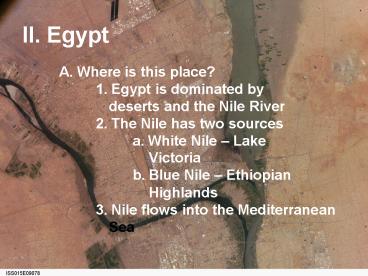II. Egypt - PowerPoint PPT Presentation
1 / 21
Title:
II. Egypt
Description:
... in ancient Egypt. 1. hieroglyphics A form of. ancient writing ... spiritual image in ancient. Egypt. a. Symbolized life. 3. Osiris Egyptian god of the ... – PowerPoint PPT presentation
Number of Views:67
Avg rating:3.0/5.0
Title: II. Egypt
1
II. Egypt
- A. Where is this place?
- 1. Egypt is dominated by
- deserts and the Nile River
- 2. The Nile has two sources
- a. White Nile Lake
- Victoria
- b. Blue Nile Ethiopian
- Highlands
- 3. Nile flows into the Mediterranean
- Sea
2
- 4. Egypt is known as the Gift
- of the Nile
- a. Floods left behind fertile
- soil
- b. Flood waters used to
- irrigate crops
- c. Only fertile farmland in
- Egypt is located
along the - Delta
3
- 5. Natural advantages of the
- Nile
- a. Fertile soil left behind
- after floods
- b. Sunny, frost- free climate
- made it easy to
grow a - variety of crops
- c. Current helps travel north
- and northern
winds help - travel south
4
- d. Granite, sandstone, and
- limestone found
there - became building
- materials
- e. Deserts surrounding the
- Nile protect the
people - from invaders
5
- 6. Isthmus A narrow piece of
- land that connects two larger
- pieces of land
- a. Isthmus that connects
- Africa to Asia is the
- Isthmus of Suez
6
- B. Anybody out there?
- Communicating in ancient Egypt
- 1. hieroglyphics A form of
- ancient writing developed by
- Nile river valley people
- 2. papyrus Kind of paper made
- by Egyptians from the stem
- of a papyrus plant
7
(No Transcript)
8
- 3. Papyrus also used to make
- a. Rope
- b. Sandals
- c. Boats
- C. I Rule the World -- Governing Egypt
- 1. Originally Egypt was divided
- into two kingdoms
- a. Upper Egypt South
- b. Lower Egypt Delta region
9
- 2. Menes, king of upper Egypt
- united both kingdoms c.
3200 - BC
- 3. He created a dynasty, or
- family of rulers
- 4. He made Egypt wealthy by
- a. Gaining new territory
- b. Improving irrigation and
- trade
10
- 5. Eventually Egyptian rulers
- would become known as
- pharaohs
- a. Means great house
- b. Pharaohs ruled with
- absolute power, or
- complete and total
- control
11
- c. Pharaohs were the
- greatest absolute
rulers - in history
- D. Kingdoms of the Nile
- 1. From Menes to 300 BC Egypt
- was split into three
kingdoms - a. Old Kingdom
- b. Middle Kingdom
- c. New Kingdom
12
- 2. Old Kingdom (2680-2180 BC)
- a. Built Sphinx
- b. Great Pyramids at Giza
- 3. Middle Kingdom (2050-1650)
- a. Hyksos Group of
- invaders from
Asia that - introduced new
war - tools
foreigners - 1. Chariot
- 2. Compound Bow
13
(No Transcript)
14
- 4. New Kingdom (1570-1080 BC)
- a. Thutmose II brought
- Egypt to the
height of its - power
- b. The worlds first female
- ruler,
Hatshepsut, ruled - during this
period - c. Amenhotep IV changed
- Egypt from
polytheism to - monotheism
15
- d. Worshipped one god --
- the sun, known
as Aton - e. Changed his name to
- Akenaton He who is
- pleasing to
Aton - 5. By 300 BC Egypt lost control
- of its country
- a. A series of invasions by
- various groups
weakened - Egypt
16
- 1. Assyrians
- 2. Persians
- 3. Nubians
- E. Egyptians Inventions
- 1. Calendar
- 2. Number system based on ten
- 3. Geometry
- 4. Discoveries in medicine
- a. Helped treat illnesses
- b. Preserved bodies after death
17
- F. Life After Death
- 1. Egyptians believed in the
- afterlife
- a. Mummification
- b. Built pyramids and other
- burial sites
- c. Put food, weapons,
- tools, and
clothing in tombs
18
- 2. Ankh Powerful religious and
- spiritual image in ancient
- Egypt
- a. Symbolized life
- 3. Osiris Egyptian god of the
- underworld and fertility
- a. Associated with the Nile
- River and agriculture
19
- G. What do we grow?
- 1. Crops grown in ancient Egypt
- a. Wheat
- b. Barley
- c. Cotton
- 2. Pharaoh owned all of the land
- in Egypt
- a. Peasants gave part of their
- crops to the
Pharaoh to pay - rent and taxes
20
- H. How do I get what I want?
- 1. Two methods to conduct
- trade
- a. caravan Groups of
- people traveling
- together over
long - distances for
safety - 1. Went into Asia and
- Africa
21
- 2. Trade by sea
- a. Egypt was one of the
- first to build
seagoing - ships
- 1. Traveled to the
-
Mediterranean and - Red Seas,
and - African coast































